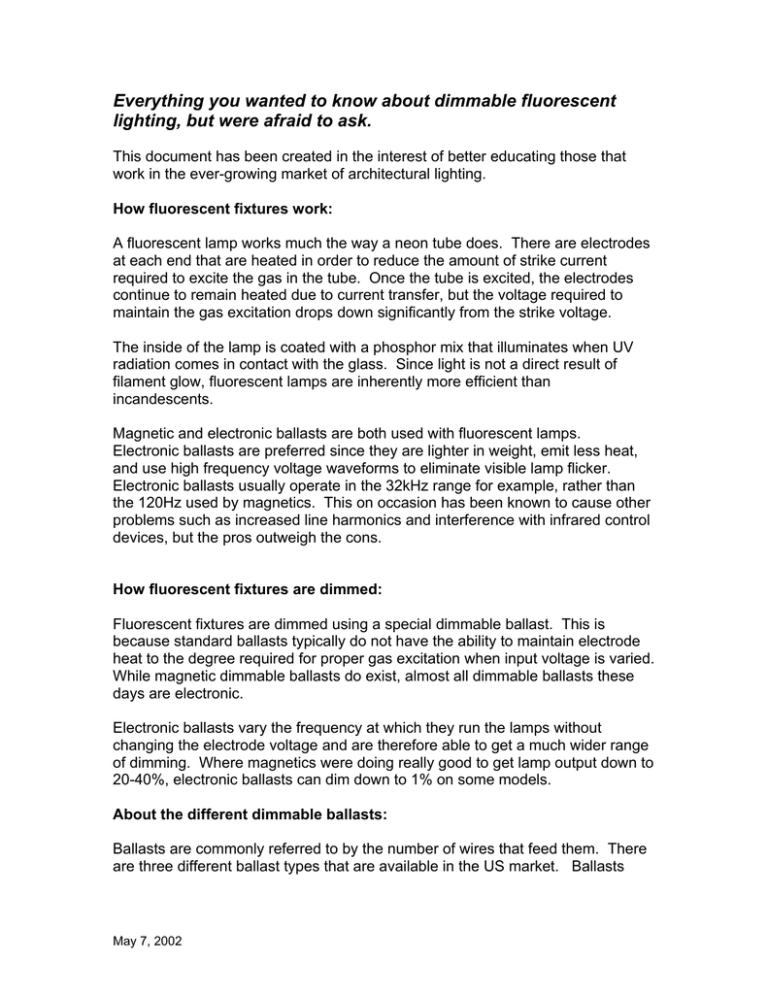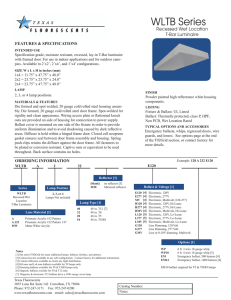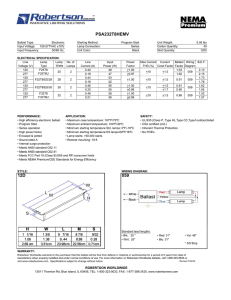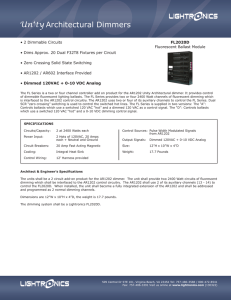Everything you wanted to know about dimmable fluorescent lighting
advertisement

Everything you wanted to know about dimmable fluorescent lighting, but were afraid to ask. This document has been created in the interest of better educating those that work in the ever-growing market of architectural lighting. How fluorescent fixtures work: A fluorescent lamp works much the way a neon tube does. There are electrodes at each end that are heated in order to reduce the amount of strike current required to excite the gas in the tube. Once the tube is excited, the electrodes continue to remain heated due to current transfer, but the voltage required to maintain the gas excitation drops down significantly from the strike voltage. The inside of the lamp is coated with a phosphor mix that illuminates when UV radiation comes in contact with the glass. Since light is not a direct result of filament glow, fluorescent lamps are inherently more efficient than incandescents. Magnetic and electronic ballasts are both used with fluorescent lamps. Electronic ballasts are preferred since they are lighter in weight, emit less heat, and use high frequency voltage waveforms to eliminate visible lamp flicker. Electronic ballasts usually operate in the 32kHz range for example, rather than the 120Hz used by magnetics. This on occasion has been known to cause other problems such as increased line harmonics and interference with infrared control devices, but the pros outweigh the cons. How fluorescent fixtures are dimmed: Fluorescent fixtures are dimmed using a special dimmable ballast. This is because standard ballasts typically do not have the ability to maintain electrode heat to the degree required for proper gas excitation when input voltage is varied. While magnetic dimmable ballasts do exist, almost all dimmable ballasts these days are electronic. Electronic ballasts vary the frequency at which they run the lamps without changing the electrode voltage and are therefore able to get a much wider range of dimming. Where magnetics were doing really good to get lamp output down to 20-40%, electronic ballasts can dim down to 1% on some models. About the different dimmable ballasts: Ballasts are commonly referred to by the number of wires that feed them. There are three different ballast types that are available in the US market. Ballasts May 7, 2002 come in 2-wire, 3-wire, and 4-wire models. These do not all exist in foreign markets. 2-wire: These are very common ballasts and the easiest to install. They require a dimmed hot and a neutral (ground is understood) and are available in 5% dimmed models from such companies as Lutron and Advance. They are installed and controlled on one dimmer just as you would an incandescent source except that a bottom-end threshold is set. This setting keeps the lamps from running below their recommended voltage, preventing premature failure of both lamps and ballasts. 3-wire: These ballasts are also common and are usually quite inexpensive. However, they use two dimmers for control and power as they require a dimmed hot, a switched hot, and a neutral (ground is understood). Advance and Lutron make them in 1%, 5%, and 10% models. A threshold like the 2-wire models is used and at the point one dimmer goes to full (non-dim) and the other begins its fade to full. The dimmer module is special since by code it must have only one breaker for both outputs. 4-wire: These are not seen as often as the 2-wire and 3-wire models. They use a hot (non-dim) and neutral (ground is understood) plus two low-voltage conductors for 0-10vdc control. They are available in 5% and 10% control models. Again, a threshold is used to set the bottom power and control voltage. Use standard dimmer modules in conjunction with a 0-10vdc control card such as the FLO board in Unison dimming. Please note that current is sourced by the ballast and sinked by the FLO board so a standard D/A will not work. There will be more on this later. About the different dimmable percentages: There are always lots of questions surrounding the dimming percentages manufacturers publish in regards to ballasts. The percentages are based on light output measured with a light meter. The human eye does not perceive light increase linearly but rather as a close function of “square law,” yet light meters do use a linear scale. Therefore, when looking at the minimum light level output by a fluorescent fixture, the eye will see more light than the percentage touted. Here is a chart to give you a better comparison between advertised or measured versus perceived light. Ballast type (what the manufacturers market) 1% 5% 10% 20% May 7, 2002 Measured light (what is seen by a meter) 1% 5% 10% 20% Perceived light (what is seen by you) 10% 22.4% 32% 46% The 5% ballast is the most prevalent of all the ballast types. It is very common for a system purchaser to not understand why their fluorescent lights do not dim down to 5%. Please help them see why 5% means light output as opposed to perceived light or control level. Important installation tips: Make sure you “season” the lamps for 100 hours prior to being dimmed. Lamps to be used in dimmed fixtures must be run at full for 100 hours. This lengthens lamp life and reduces flicker and end cap blackening. Many people do not know this until they start running through lamps frequently and call for help. It is recommended that a few fixtures be purchased and installed in the storage room to provide a lamp burn-in area. Make sure the fixtures are adequately grounded. The lamp must be in close proximity to a metal ground plane in order to reduce flicker and increase lamp life. The distance should be 0.5” within +/- 0.25”. Do not mix ballast or lamp types on the same circuit. Contrary to popular belief, ballasts can interact with each other on the same circuit. The same is true for lamps as they do fire differently and should never be mixed within a fixture. Please use the following chart to determine the correct ETC dimmer module for your ballasts: 120VAC 277VAC 2-wire L10/D15/D20 AL5/AD20 3-wire D15F/D20F AL5F/AD20F 4-wire L10/D15/D20 AL5/AD20 There are some new dimmer modules available that help deal with very low numbers of ballasts on a circuit. Since SCR based dimming requires a minimum load to operate correctly, ETC has developed modules that are better able to deal with situations where only a ballast or two is on a dimmer or the ballast is highly inductive or capacitive. The L series of modules use MOSFET and IBGT technology to more accurately dim low wattage loads. How to tune an ETC Unison system for dimming fluorescents: When configuring the dimming engine on a Unison processor, please verify that you select the correct module type and the appropriate load type. When you select fluorescent, you will be asked what percentage ballast you are using. The curve and threshold will be set automatically. How to tune an ETC Sensor system for dimming fluorescents: May 7, 2002 Sensor is quite a bit different in how it should be set for proper fluorescent dimming. You must first set the curve you wish to use. Most people select Linear, but there is a Modified Linear as well that has a softer bottom end of the curve. After that, set the Threshold to about 60% and measure the RMS voltage output for the dimmer at its minimum setting. You are looking for voltage to be 0.47 times the incoming line voltage. If 60% is not correct, select another Threshold that is closer to the desired output and verify with the meter. With this type of setting (let’s assume 60% Threshold) your fader will have a large area of travel (between 0 and 59%) where nothing will happen. On Unison systems, you can set the Zone to have a minimum level of 60, maximum of full and select the box labeled, “Use zero as off.” This will give your wallstation fader complete control of the ballast across the entire range of the fader and still turn off at the bottom of the fader travel. This is a very nice solution. When running ballasts from a DMX control console, take time to program a profile to emulate the Unison programming, or record all you cues with those affected channels between 59 and full. That way a timed fade will still operate with all fluorescent and non-fluorescent channels in parallel. Troubleshooting dimmed fluorescents: 1. Lamps are at different levels on different ballasts 2. Lamps have blackened ends 3. Lamps flicker or flash at low levels only 4. Lamps flicker or flash at all levels 5. Lamps come on at full at low-end of control and do not dim. 6. Lamps do not dim to the lowest level May 7, 2002 - Mixture of different types or ages of lamps. - Lamps were not seasoned at full for 100 hours. - Lamps have been run for long periods of time at very low levels. - Lamps have been run below recommended levels. - Lamps were not seasoned at full for 100 hours. - Ballasts are being driven too low. Verify low-end RMS voltage setting. - 3-wire ballast has dimmed and switched wires swapped. - Lamps were not seasoned at full for 100 hours. - Lamps and ballasts not matched. - 4-wire ballast has missing or incorrect wiring for control. - Lamps were not seasoned at full for 100 hours. - Fixtures incorrectly grounded. - Aged lamps. What ballasts not to use with ETC equipment: Do not use reverse-phase control ballasts. All Sensor and Unison dimming systems (and all SCR-based dimming systems manufactured) use forward-phase control. The use of ballasts not intended for these systems will cause a variety of problems and will not dim correctly. The most common manufacturer of these ballasts is ESI. Lightolier makes a converter box in one and two-channel models to adapt the forward-phase control signal to reverse-phase control, but the cost is quite significant. Most dimmable ballasts made today are electronic and are easy to work with. However, as people are retrofitting older facilities, dimmable magnetic ballasts are being used as well. Most magnetics can be dimmed, but as always, if there is any doubt, test it first. Magnetic ballasts must be thermally protected to prevent non-sinusoidal waveforms from causing overheating. I hope this helps you understand a few basics about dimmable fluorescents and how to make them work for you and your facility for years to come. May 7, 2002




